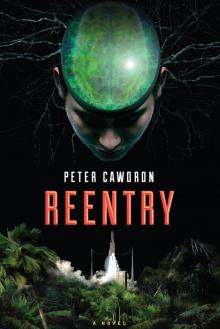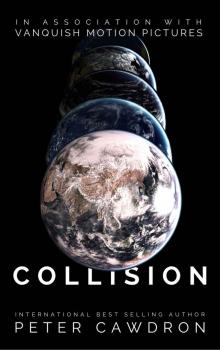- Home
- Peter Cawdron
Anomaly Page 2
Anomaly Read online
Page 2
Teller was devastated.
He drove to the spot where she'd lost control and was shocked to see how little there was revealing the tragedy. There weren't any obvious skid marks. She'd missed the safety barrier leading into the corner by less than a foot. A fraction of a second had made the difference between life and death. The lowlying shrubs and trees along the bank had some bark scraped off them and a couple of broken twigs, but nothing more than that. There was a slight indentation where the wheels had crossed the shoulder of the road, just a couple of errant tire tracks in the soft clay. The drop to the water was no more than fifteen feet, but the lake was deep. The police said her car would have gone under in seconds. They were kind and professional. They told him there was a mark on the side of her head where she'd hit the pillar of the door as the car twisted on impact with the water. This, they said, would have knocked her unconscious. She wouldn't have felt anything, no pain, no fear.
Teller struggled with the senseless loss. The swiftness with which a beautiful life had been lost left him in shock. He blamed himself. He could have gone with her, he should have gone with her. He should have been driving. Things would have been different, he was sure of it. But there were no second chances in life, no re-runs, and all Teller had left was a sense of guilt and loss.
Teller dropped out of college. He worked as a waiter for a few months, and tried to find solace in a bottle but that only made his despair worse. It was his sister who came to the rescue. She was a preschool teacher. She dragged him along on a couple of field trips to help out with the kids. Teller was surprised by how much he enjoyed himself. The kids were little horrors, but that didn't seem to matter. He found a sense of joy in their inquiring minds.
Teller returned to college determined to become a teacher and excelled where once he had floundered. The East Side Village Community School was his second teaching position, and he loved it.
It was Monday morning.
The anomaly had dominated the news over the weekend.
The kids from his fifth grade class poured into the classroom in an avalanche of noise and confusion, yelling and laughing, pushing and jostling with each other. They came from a kaleidoscope of social backgrounds, and he loved their diversity. The world should be more childlike, he thought, the kids didn't care about the color of someone's skin or the style of clothing they wore. All they cared about was playing ball. In their innocence, they hadn't learned to separate into religious or social cliques. And the reason was clear, they all had one thing in common, their excitement for life.
Teller sat on the edge of his desk at the front of the classroom. He flicked a switch as the commotion died down and the overhead projector hummed, showing an image of the United Nations building just a few miles north of them. The kids reacted immediately, pointing at the screen and talking over the top of each other, their eyes lighting up.
The slab of concrete that previously formed the middle of the intersection lay on a steep angle over against East 45th Avenue, tilting toward the morning sun rising slowly over the river. Twelve floors carved out of the State Department building were suspended in the sky, hundreds of meters above a gaping hole in the ground. The flags were just a foot or so above the road, but they were slowly moving toward their severed flagpoles still standing inert beside the UN building. They fluttered in the breeze, apparently unaware of how remarkable it was for them to be disembodied and levitating.
Several trailers had been set up around the roads approaching the intersection, portable site offices established for the engineers and scientists who had gathered from around the country, but the largest contingent was just outside the barricade. It was the media. All the major networks were present. The park adjacent to the UN building had become a sea of tents and trailers.
“OK,” said David Teller. “I'm guessing from your excitement you all saw the news over the weekend. So, who knows what this is?”
Hands shot up in the air as the kids responded to his well-rehearsed routine. They all wanted to be the first one to blurt out the answer. Several kids were calling out over the top but Teller ignored them, picking out Johnny, a young black child sitting in the middle of the class. Johnny stood and spoke proudly.
“It's the anom-ma-la-ly. At least, that's what they're calling it on TV.”
Teller smiled.
“It's a funny word, isn't it?” he said. “It's a bit hard to get your tongue around. Why do you think they're calling this an anomaly? Does anyone know what the word anomaly means?”
Susan Parker sat in the front row. She was an exceptionally bright student from a Hispanic background. Her father was a drunk. Her mother worked nights, trying desperately to raise her family out of poverty. Teller had high hopes for Susan. She had the potential to go far, far beyond the East Village. He picked Susan. She stood up, feeling proud.
“An anomaly is something strange or unusual, something that is not normal.”
“Very good. Do you think this is an anomaly?” he asked.
Her face beamed. She enjoyed being asked her opinion. She responded with an emphatic “Yes.”
“Why is it an anomaly?” Teller asked, trying not to trip over his own words. The phrase an-anomaly was a tongue twister.
“Because this isn't natural,” one of the more impulsive students blurted out.
Teller smiled, saying, “No, it's not. Is it?”
Teller moved his computer mouse and brought up a time-lapse video clip that condensed the motion of the anomaly over 24 hours down to 60 seconds. The students watched in awe as the slab of concrete, the flags and the building fragments shifted effortlessly through the air. Spotlights lit up the motion of the slab over the course of the night.
Despite some reports to the contrary, the concrete slab within the intersection never turned completely upside-down. At its peak, it tilted down on a wildly unexpected angle, moving in a smooth arc as it swung through the air over toward East 45th Street. The anomaly was moving off-center as it turned over on itself.
Watching its daily motion compressed into a minute, the arc reminded Teller of being at the circus as a child, watching a motorcycle warm up inside the wheel of death. The name had been so dramatic – no one ever died. But the steel cage, in the shape of a large ball some thirty feet in height, was impressive. As the motorcycle inside the cage got up to speed, it would start with small loops that didn't cross directly overhead. The bike would go faster and faster until it went upside-down over the inside of the cage as the crowd roared with excitement. To Teller, the anomaly seemed stuck in those warm up loops. It moved effortlessly through the air, twisting and turning upside down, but never making it entirely upside down before twisting back toward the ground.
By midnight, the slab was over a hundred meters above the road, tilting down at the ground on an acute angle. The concrete intersection faced north, looking down along 1st Avenue as it floated above the gaping, concave hole in the ground. The traffic lights and the tree on the levitating slab pointed down at the road below at a sharp angle.
As dawn broke, the slab had twisted sideways over by East 45th, slowly sliding down into the hole in the road as the sun rose in the sky. By noon, all the pieces of the jigsaw puzzle appeared to have moved back in place before they set off again on another circuit.
The clip looped, repeating every minute, always showing the unnatural sight of the flags, the dismembered floors from several buildings and the intersection rotating freely through the air.
“Do you know what it is, Mr Teller?” asked Susan.
“Oh, I know what it is,” said Teller, raising his eyebrows slightly as he leaned forward toward his students.
The class went silent as he continued.
“I know exactly what it is.”
He paused slightly, enjoying their rapt attention. For Teller, this is what teaching was all about, inspiring young minds.
“It's interesting.”
The kids looked perplexed.
“It's fascinating.”
“No,” cried one of the children from the back. “What is it really?”
“It really is interesting,” repeated Teller smiling.
A couple of the kids sighed, they were clearly hoping for more from their science teacher.
“You see, science isn't about having answers,” Teller began. “It's about having questions. That is what makes the anomaly so fascinating. We don't know what it is. We don't know how it moves the pavement around or why those flags don't fall to the ground or how those sections of the buildings are suspended in mid-air, all rotating around some invisible, imaginary point in the middle of some giant imaginary orb. We have no idea how this could happen and that makes it exciting. Scientists love questions.”
“I like answers,” said one of the Asian boys sitting next to him.
Teller laughed. “We all like answers. But there are some things in life for which there are no answers, just lots of questions. So how can science help us with this question? What do you think the scientists are doing down there?”
“Are they scanning it?” asked one of the pretty Indian girls.
“Hmm,” thought Teller. “I'm sure they are scanning it with something. In the movies, they'd have a fancy scanner that could tell them all about the anomaly, but for real scientists, things aren't quite so simple.”
“What else?” Teller asked, provoking some thought among the children. “What else do you think they're doing? What do you think we can learn about the anomaly?”
Johnny stood up. “We can't learn anything, because we don't know anything about it.”
“Well, not quite,” said Teller softly. “There's a lot we know about it already.”
That got everyone's attention. Teller looked around the classroom. Several of the kids were leaning forward on their desks, their elbows on the tabletops, their heads resting on their palms. He had them eating out of his hand.
“So we know how big it is. Whatever this anomaly is, it has a diameter of roughly 130 meters, that's about 425 feet. Can anyone tell me why we describe its diameter in meters instead of feet?”
There was silence. No one wanted to offer an answer.
“We use meters, or metrics in science rather than miles, yards, feet and inches because metrics work in units of ten, making it easy to calculate. Everyone knows how to multiply by ten, right? Scientists are weird creatures. They're really smart, but being smart they know how easy it is to make dumb mistakes, so instead of using old style measurements, they simplify everything. Isn't that clever? They use a simple measuring system to make hard calculations that little bit easier.”
Heads were nodding.
“So if the anomaly has a diameter of 130 meters, what is its radius?”
Teller could see the kids thinking, within a few seconds one of them blurted out, “70.”
“65,” he replied. “But 70 is a good approximation. So the diameter is the width of a circle, whereas the radius is half of that. Why is it so important to know the radius? What is it about the radius that makes it important for us to understand?”
Frowns appeared on brows around the room as the kids fought conceptually to see where he was leading them. Susan knew. Her arm was outstretched in a flash, but Teller kept her waiting. He wanted to see who else would figure it out. After a few seconds, he pointed at Susan. She jumped to her feet again.
“The radius is the distance from the center of a circle to the edge.”
“And why is that important when it comes to our wonderfully curious anomaly?”
“Because it shows us where the center of the anomaly is?” Susan ventured, going out on a limb with her answer.
“Exactly,” said Teller. He paused the time-lapse video and pointed roughly at the middle of the open air, between the flags, the building fragments, and the concrete slab.
“And look at that. The center is somewhere high above the ground. It's in this area right here. Everything is revolving around an invisible axis running right through here. On the news, everyone talks about the flags or the concrete slab because you can see them and they look impressive, but the really important part of the anomaly is right here, in this empty bit, because that's the center around which everything revolves.”
The kids were hanging onto his every word.
“So you see,” he continued. “This is all the math and physics we were doing in the first semester. If the anomaly has a diameter of 130 meters, then its circumference is its diameter times pi, making it almost 400 meters round, so it would take quite a while to walk around the edge. It would be like walking the length of four football fields.
“Oh, and our anomaly isn't a flat circle, is it? Although we can't see most of it, as it is mostly made up of air, it is a sphere. We can't see all of it, but it's in the shape of a giant marble or a giant soccer ball. And objects in three dimensions are much bigger than those in two dimensions. Our anomaly has a surface area of over 50,000 square meters, so if you wanted to wrap it up for Christmas you'd need an awful lot of fancy paper.
“Remember the concept of volume? That's how much stuff something can hold. Well, our anomaly holds over a million meters cubed.”
There were blank looks on the faces of the children. Although it was an impressively large number, it meant nothing to them in practice.
“How many of you have been swimming in the Olympic pool over near the FDR on-ramp?”
Hands went up all around the classroom.
“Well, it would take over four hundred of those swimming pools to fill up our anomaly.”
The scale of the numbers surprised and fascinated the children. They laughed and giggled at the thought. That put a million meters cubed in perspective for them.
“Wouldn't it leak out?” asked Susan rather seriously.
Teller smiled and said, “Yes, it would. But if it was a sealed container it would hold all that water, and that tells us something important about its capacity. It tells us how large it is. And one of the first things the scientists would have looked for was to see if it was growing, if its capacity was increasing, but it's not. It has stayed the same for several days now. You see, all of these small details help us build up an accurate understanding of the anomaly, they help us to understand the nature of what we're dealing with.”
“And we also know how fast it is moving,” he continued. “Who can tell me what speed is a measure of?”
One of the quieter boys at the back raised his hand. Teller nodded.
“I know that one,” said the boy. “Because it's like a car, isn't it? It's miles per hour, or how many miles you would go after driving for one hour.”
“Very good,” said Teller, complimenting the young boy. “Whether we are talking about miles per hour or kilometers per hour, speed is the distance an object moves over a certain period of time.”
“Our anomaly is actually moving very slowly. Its circumference is 400 meters, and it takes one full day to turn around, so it is turning at 400 meters per day or only 16 meters in an hour. That's about the length of this room in one hour. So in the time you're sitting in this class, that's how far the anomaly has moved.”
Almost in unison, the kids all looked from the back of the room to the front. Having a visual yardstick helped them put things in context.
“I can ride my bike faster than that,” cried one of the kids.
“I can walk faster than that,” added another.
“I could wiggle on my belly faster than that,” added a third.
“Yep,” said Teller. “As impressive as our anomaly is, it isn't actually moving that fast at all, is it?”
“No,” the class replied.
“But do you want to know what is the most interesting fact about the anomaly?”
The classroom was quiet with anticipation, watching as Teller switched computer programs, bringing up a high-resolution image of the concrete slab. It was taken as the slab reached its zenith, while it was tilting down at the road. He zoomed in on the floodlit gutter.
“Look at the lit
ter. Look at the scraps of paper, the leaves and the small twigs. Oh, and there's an empty McDonald's shake and a coke can.”
The kids all looked, unsure of the importance of some trash lying in a gutter.
“Look at the leaves of the tree and the traffic light. They're all hanging up instead of swinging down. The most amazing thing about our anomaly is that the trash hasn't fallen. Our anomaly is defying gravity.”
There were smiles as a sense of wonder and awe dawned on the children.
“So what would happen if you were standing there?” asked one of the girls. “Would you fall off? Would your hair hang down?”
“I expect you'd stand there thinking you were the right way up, wondering why the rest of the city was on such a silly, topsy-turvy angle.”
The children laughed.
“There's a lot of other interesting things we can know about our anomaly, and all of them help make it not-quite-so-scary. We can calculate the force with which it's moving. We can calculate the angle on which it is moving, because it's not turning completely upside-down as it flips over the top, so it is moving on a slightly different plane than what we'd expect.”
“But we still don't know what it is,” Johnny insisted as Teller started handing out parent permission slips.
“No, we don't,” replied Teller. “But we know it's interesting. And tomorrow, we're going to go and see it for ourselves.”
And that put a smile on all their faces.
Chapter 03: Contact
Less than half of the class brought back permission slips allowing them to go on the field trip to see the anomaly first-hand, which disappointed Teller, although it seemed it wasn't for lack of trying on the part of the kids, who were all still enthusiastic, pleading with him to let them go. Teller couldn't take them against their parents’ wishes. He was pleased to see Susan got permission from her mother. Susan said something about her uncle being there, but Teller missed it in all the commotion.

 Alien Space Tentacle Porn
Alien Space Tentacle Porn Reentry
Reentry Déjà Vu (First Contact)
Déjà Vu (First Contact) Wherever Seeds May Fall (First Contact)
Wherever Seeds May Fall (First Contact) But The Stars
But The Stars Trixie & Me
Trixie & Me Collision
Collision Jury Duty (First Contact)
Jury Duty (First Contact) Losing Mars
Losing Mars We Are Legion (van Helsing Diaries Book 2)
We Are Legion (van Helsing Diaries Book 2) Van Helsing's Diaries (Books 1-3): Nosferatu
Van Helsing's Diaries (Books 1-3): Nosferatu Shadows
Shadows 3zekiel (First Contact)
3zekiel (First Contact) Vampire (van Helsing Diaries Book 1)
Vampire (van Helsing Diaries Book 1) Xenophobia
Xenophobia All Our Tomorrows
All Our Tomorrows My Sweet Satan
My Sweet Satan Anomaly
Anomaly Monsters
Monsters